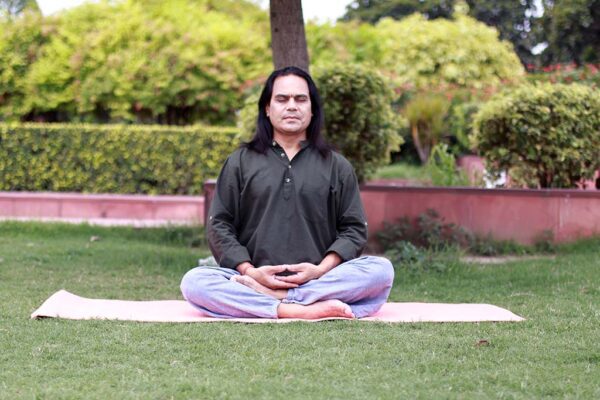
In today’s fast-paced world, our minds often feel like a restless monkey—jumping from one thought to another, rarely pausing to rest. The constant notifications on our phones, endless to-do lists, and pressure to keep up with everything around us can leave us feeling exhausted and disconnected from ourselves.
But if we look back at our ancient Indian traditions, we find a timeless treasure—Mindfulness. Though the word “mindfulness” may sound modern and trendy, the practice itself has deep roots in ancient yogic wisdom, where it was woven into daily life as a natural way of living. The sages called it smriti (remembering) or sakshi bhava (witness consciousness).
Mindfulness is not just a meditation technique; it is a way of living with awareness, presence, and compassion. In this blog, we’ll explore how ancient yogic teachings can guide us to bring mindfulness into everyday life—whether we are commuting to work, cooking a meal, talking to a loved one, or simply sitting quietly.
The Yogic View of Mindfulness
In the yogic tradition, mindfulness is about being fully present in the moment, without judgment or distraction. It is about living consciously rather than mechanically. The Patanjali Yoga Sutras, a foundational text of yoga, describe practices that naturally cultivate mindfulness through Ashtanga Yoga (the eight limbs of yoga).
The key yogic concepts related to mindfulness are:
- Pratyahara – withdrawing attention from distractions and turning inward.
- Dharana – focused concentration on a single point or task.
- Dhyana – continuous, effortless meditation and awareness.
In simple terms, mindfulness is about shifting from “doing” mode to “being” mode. Instead of rushing through tasks, we slow down, observe, and engage with life fully.
Why the Modern Mind Needs Ancient Wisdom
Modern life often demands multitasking, but our brains are not naturally wired for it. Constant switching between tasks increases stress and reduces efficiency. Ancient yogic wisdom teaches us the opposite—single-tasking with full attention, which not only improves performance but also brings a deep sense of peace.
The benefits of mindfulness for the modern mind include:
- Reduced stress and anxiety
- Improved emotional balance
- Better focus and memory
- Enhanced relationships
- Greater sense of purpose and contentment
Practical Ways to Bring Mindfulness into Everyday Life
Let’s see how we can apply ancient yogic mindfulness practices in our daily routine.
1. Mindful Morning Ritual
The way we start our day sets the tone for the rest of it. In ancient India, mornings began with Brahma Muhurta—waking up before sunrise, offering gratitude, and engaging in spiritual practices.
Modern Application:
- Wake up a little earlier, avoid checking your phone immediately.
- Sit quietly, take a few deep breaths, and set an intention for the day.
- Practice Sun Salutations (Surya Namaskar) mindfully, feeling each stretch and breath.
2. Mindfulness in Eating (Bhojan Vidhi)
In yogic tradition, eating is considered a sacred act. The Bhagavad Gita describes food as an offering to the divine within us. Eating with awareness improves digestion, prevents overeating, and helps us connect deeply with our body.
Modern Application:
- Eat without TV, phone, or distractions.
- Observe the colors, aroma, and texture of food before eating.
- Chew slowly, savoring each bite.
- Offer gratitude before meals.
3. Mindful Breathing (Pranayama in Daily Life)
Breath is the bridge between body and mind. When we breathe consciously, the mind naturally becomes calm and present.
Modern Application:
- Take short breaks during the day to practice deep breathing.
- Use Anulom Vilom (alternate nostril breathing) before meetings or stressful events.
- In moments of anger or anxiety, take five slow breaths before responding.
4. Mindful Listening & Speaking
In yogic philosophy, Satya (truthfulness) and Ahimsa (non-violence) also apply to our communication. Speaking mindfully avoids misunderstandings, while listening mindfully deepens relationships.
Modern Application:
- While talking to someone, give your full attention—don’t think about your reply while they are speaking.
- Avoid interrupting.
- Speak slowly and clearly, with kindness in your tone.
5. Mindful Walking (Yogic Way)
Walking meditation is a beautiful way to combine movement with mindfulness.
Modern Application:
- During a walk, notice the ground beneath your feet, the rhythm of your steps, the sensation of air on your skin.
- Avoid walking with your phone in hand.
- If walking in nature, connect with the sounds of birds, rustling leaves, and sunlight.
6. Mindfulness in Work
Ancient yogis taught Karma Yoga—performing actions with complete awareness and without attachment to results. This is mindfulness in action.
Modern Application:
- Focus on one task at a time.
- Keep your workspace clutter-free to reduce mental distractions.
- Take short breathing breaks every hour.
7. Mindful Evening Reflection
In Indian tradition, evenings were a time to light a lamp, offer prayers, and reflect on the day.
Modern Application:
- Spend 5–10 minutes journaling: What went well today? What could be improved?
- Practice gentle yoga stretches to release tension from the day.
- Avoid heavy screen use before bed.
Mindfulness Meditation – A Simple Daily Practice
Here’s a step-by-step yogic mindfulness meditation you can do in 10–15 minutes:
- Sit comfortably in Sukhasana (Easy Pose) or Vajrasana (Thunderbolt Pose).
- Close your eyes and relax your shoulders.
- Bring your attention to your breath without trying to change it.
- If thoughts arise, acknowledge them and gently return to the breath.
- Gradually expand awareness to your body sensations, sounds, and surroundings.
- End with a silent prayer or gratitude.
Ancient Wisdom Tips for Staying Mindful
- Abhyasa (Practice): Make mindfulness a habit by practicing regularly.
- Santosha (Contentment): Accept the present moment as it is.
- Satsang: Spend time with like-minded people to strengthen your practice.
- Seva (Service): Helping others mindfully cultivates compassion.
The Deeper Spiritual Dimension
From a yogic perspective, mindfulness is not only about stress relief—it’s a doorway to self-realization. By observing the mind, we begin to see that we are not the mind; we are the pure awareness behind it. This is the essence of Vedantic wisdom—Tat Tvam Asi (“That Thou Art”).
The more mindful we become in everyday life, the closer we move towards inner freedom (moksha).
Conclusion
Mindfulness is not something we need to “find”—it is our natural state, waiting to be uncovered beneath the noise of daily life. Ancient yogic wisdom gives us the tools to live mindfully in every moment, whether we are on the mat, at work, or with family.
The modern mind may be restless, but with gentle and consistent practice, it can be trained to rest in the present moment—where life truly happens.
So, starting today, let’s carry the spirit of mindfulness into everything we do. As the old Indian proverb says:
“When walking, walk. When eating, eat. When breathing, breathe.”
That is mindfulness. That is yoga in action.
















